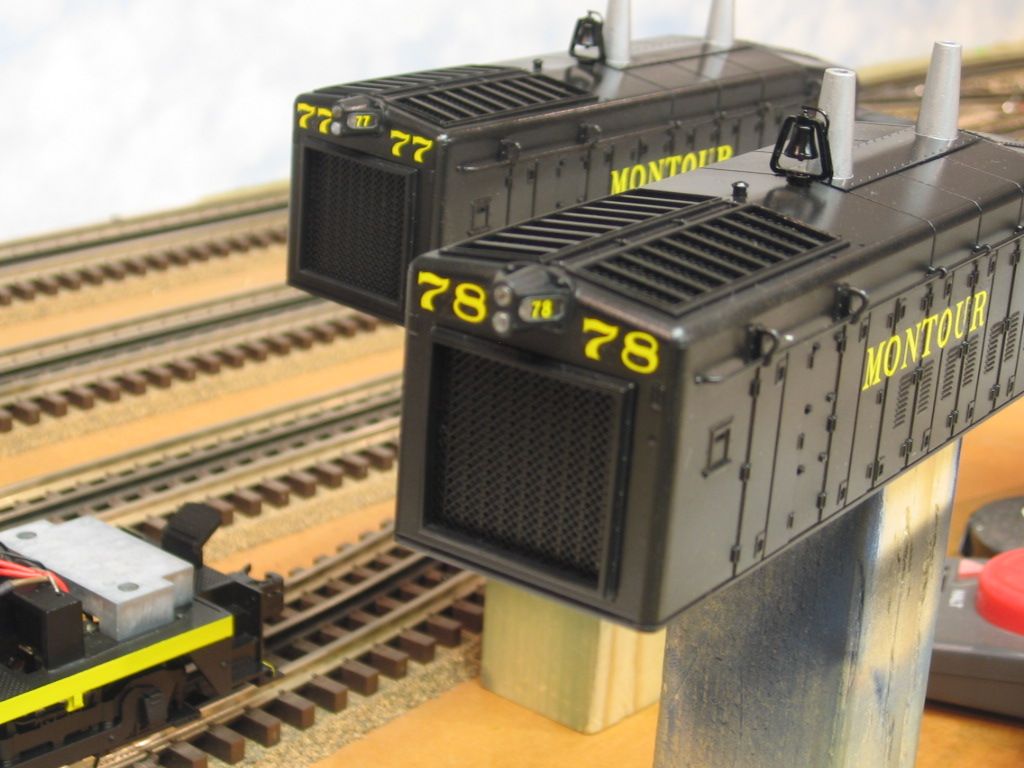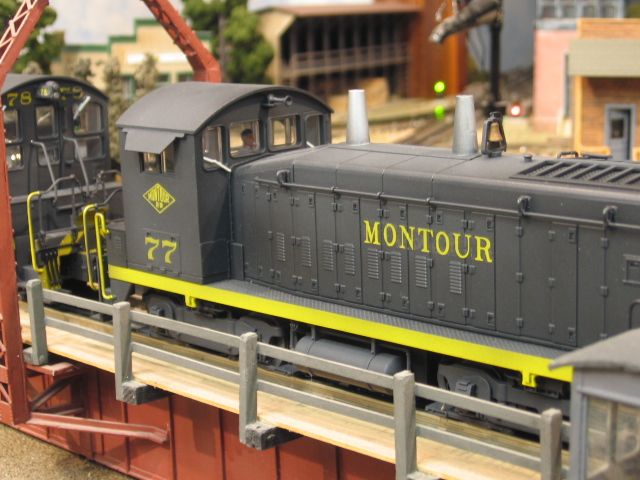I'm painting up another Weaver B60 baggage car for Penn Central and have arrived at the dreaded final clear coat stage. Last time I did this I used Tamiya brand not knowing about the dangers of "hot" lacquer and it blistered the decals. Currently the model has a gloss finish for proper decal application, but this is unrealistic for Penn Central so I need to put a final dull coat on it one way or another. Can any of the painters here suggest a specific product that will not destroy Microscale decals and will also be thin enough to not blot out fine details? Also, the base paints I used were Tamiya lacquer colors for plastic, if that makes a difference for lacquer / enamel compatibility. Thanks in advance.
Replies sorted oldest to newest
Can't say for sure, not having used Tamiya brand paints, but over the many decades I've painted/decaled, I've had zero issues using Testors Dullcoat sprayed from the rattle can into a small paper cup, and then poured into the airbrush bottle and shot through my Binks airbrush system. This primarily was over-spraying Floquil paints, but also included a host of other solvent based paints. Never had a paint or decal problem using Testors Dullcoat.
Good luck!
Andre
Have had no problems with Testors Dullcote; kinda the Standard. I use the spray can;
the results are fine - I use an airbrush only for weathering, as I detest them. My decals
are Microscale or Champ or even old Walthers. I've been doing this since the 1980's.
(Actually I discovered Dullcote in the early 1960's when I was 14 and assembling 3-in-1
auto kits; really looked good on manifolds and (yes) even chrome bumpers. So, it
works.)
Like any clear coat sprayed too thickly too soon it can get "milky". This is Operator
Error. I always spray multiple thin coats.
I use Floquil flat finish. Straight from the bottle, it will have a very slight sheen to it, but is mostly flat. If it is thinned, it will be dead flat. It dries very quickly. I have been using it for years and it's my favorite. Unfortunately, Testors is phasing out this product line. ![]() There is still lots of it around if you look.
There is still lots of it around if you look.
High humidity can also cause a milkey appearance. Dullcote is hard to beat.
George Lasley
Thanks guys. The Testors you're all using, is it a lacquer or an enamel? It seems to me the lacquers would be more dangerous to the decals? And yes I agree about airbrushes. Was really trying to steer clear of that hassle and expense if a safe can option is available.
Here's the model getting the treatment:
Attachments
I just went and looked at the last can I purchased and it says on the side: "Dull Coat: Flat Lacquer Overcoat"
Nick,
I use the Testors in the bottles in my airbrush. I mix 1/1/1 dullcote/glosscote/laquer thinner. It leaves a light sheen and has just the right "bite" left to apply weathering. As said before Testors and humidity are not friendly.
Malcolm
Thanks guys, I'll head to the LHS tomorrow for a can. Although about this humidity, I'm in Southwest Florida and while I've never had a clear coat go milky on me before this is also the first time I'll be using Testors. Will have to just spray inside.
Decals don't react to the clear coat per se. They are more likely to show the effects of a top coat reacting badly to whatever it's covering. In general you can use progressively less aggressive carriers without issue, aka first coat lacquer, second coat enamel, third acrylic, assuming you have allowed the previous coat to fully harden. A more aggressive thinner can eat into softer coatings it comes into contact with and make a messy goo.
I would caution you to spray from the can in good weather. Say around 65 degrees at about 40% humidity. Don't hold the can over the work because it might accumulate and make a dreaded "DRIP" that would be like 5 scale feet thick on the model.
Easy does it. A little bit goes a lotta bit.
I recently did a bunch of models paint and decals both CDS dry transfer and Microscale so got a bunch of stuff to clear coat and tried to use the Micro Scale Micro satin but it plugged my air brush could not get it to flow at all even after a really good mix.
Went to local hobby shop and got Tamiya color for plastics flat clear.
It went on ok but when dry the decal film showed up even worse then before clear coated.
Stopped by Michaels today and all they had was the Testors gloss cote might try this at some point on another project.
Interested in suggestions to best hide the decal film
If you're going to use the spray can of Testors Dull Cote, I would let the can soak in some hot water before using it. Help thin it down some and get a nice light even spray.
I personally would never use a spray can on a car after a custom paint/decal job. I use the Dull Cote in a bottle, thinned 50/50 with lacquer thinner, and of course the airbrush. Never had an issue with that.
Happened to think: Could be those of us using Dull Coat through an airbrush also don't have issues because we can lay it on "drier" than when it comes straight out of the rattle can? I don't know. I've done it for so long I do it without thinking about technique. ![]()
There is a note in the instructions about 24hrs. or more drying time.
Testors Dull coat. Click to access.
From the Testors website.
"Dullcote Lacquer - 1 3/4 oz. - Dullcote is a lacquer-based clear overcoat, used to seal and protect painted surfaces. It is used for altering glossy surfaces to give them a flat look, and to protect decals. It can be used over all Testor/Pactra/Model Master enamels and acrylics, when latter have dried at least 24 hours or more. If you need to thin, use 1159X Thinner Only"
I applied Dull coat before final assembly. I wasn't sure what it would do to clear plastic windows.
Gloss coat before decals. Decals by nature are glossy requiring a gloss coat before application, IMO, or at least that what I was told when I asked here on the forum. 

Dull coat applied with a dusting of grimy black overspray.



Additional picture added.

Thanks for all your help everyone. I just gone done spraying the car and the Dullcote was indeed the trick. Although I actually didn't totally like how flat it came out, since it muted all the rivet detail of the car. No matter, as it still served as a protective barrier for a hotter semi-gloss. The car is drying now, will post photos when it's completely cured.
Could you define the term "hot", as you're refering to it. I know it's professional painter's slang, but being a professional painter for the last 25 years, I can't figure out what you're doing. Dull-coat is about the "hottest" paint I can think of, both pro and homeowner. What "hotter" semi-gloss are you putting over the dull-coat? "Sandwich" is another painter term I'm familiar with, and if you're doing that, it's going to be trouble.
I'm thinking of a way to help with your past problem so it doesn't happen again. An example would be that Krylon will go over the dull-coat, but Rustoleum will not, etc... If you let us know what "hot stuff" you are using, it would be easier to provide advice.
Although I actually didn't totally like how flat it came out, since it muted all the rivet detail of the car.
That's a very common result when using Dull-Cote from the spray can. It comes out thick and heavy. If you mix your own from the bottle, 50/50 with lacquer thinner, and use an air brush, that won't happen.
In normal temps, it will dry in 15-30 minutes.
Could you define the term "hot", as you're refering to it.
I picked up use of this term while researching my previous accident. A lot of people were using it on model car and tank forums, and I took it to essentially mean the level of chemical aggression of the paint. In my previous accident, I used Tamiya TS-79 Semi-Gloss as the first coat over the decals and Tamiya brand base coats. While the final sheen was exactly what I wanted, it badly blistered the decals. Looking it up I found another modeler on one of those forums talking about how Tamiya brand was way too "hot" for clear-coating decals.
For whatever reason it would appear Testors Dullcote is not as aggressive, and sealed the decals without blistering them. Then I applied the Tamiya TS-79 that I like so much and the Dullcote did its job by serving as a barrier to prevent the Tamiya from attacking the decals. That's my amateur understanding of it all.
Although I actually didn't totally like how flat it came out, since it muted all the rivet detail of the car.
That's a very common result when using Dull-Cote from the spray can. It comes out thick and heavy.
Sorry for the confusion, that's not what I meant. The Dullcote came out of the can perfectly thin, but it was too flat for the light to reflect off the car and highlight all the rivet detail. Essentially no light reflected at all and the result was a completely lusterless green block. However it still served as the necessary protective barrier to apply my choice clear coat that ruined the decals last time. In a semi-gloss finish I can see all the rivet detail again and it matches the finish of the rest of the train.
Ahh, gotcha...Dull-Cote is definitely very very flat. A lot more than several other flat finishes.
I have used lots of different top coats. Paint formulae are changing rapidly, and what worked yesterday may not work today. I had a beautifully painted and decalled Williams T1, and I shot it with Scale Coat clear, thinned with Scale Coat thinner. The underlying brunswick was also Scale Coat, and had dried for a decade. Decals came in the box, but were of reasonable quality. The clear was ok on the decal, but started to eat the base paint!
I saved it - the minute I saw the paint start to curdle, I stopped, let the mess dry for a week, shot a coat of Future Floor Wax on it, and re- applied the clear.
I am in agreememt with the above - a very thin coat applied with an air brush will usually work. But again, things have changed dramatically in the paint world. Forget about the rattle cans - they are generally meant for furniture or something. Krylon used to be my favorite for quick jobs, and it is now worthless for modeling tasks - or anything else I have tried lately. The new Krylon will eat itself, but will not cover the way it used to.
Opinion.




